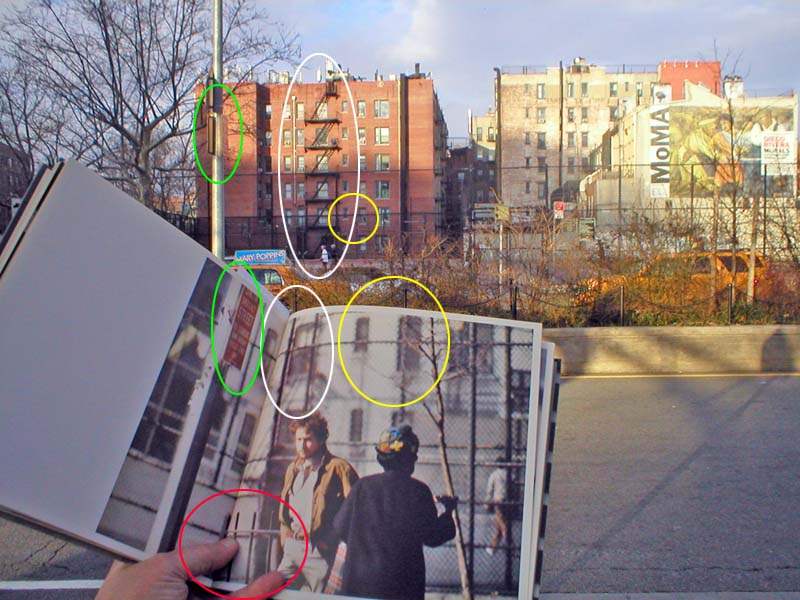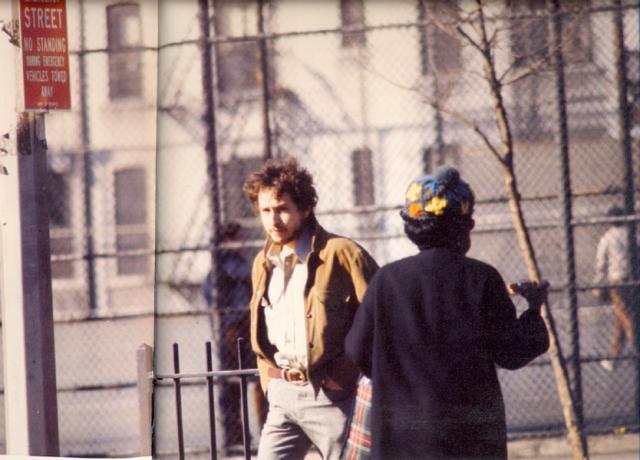 | |||
 | |||

|
Photos of Bob Dylan by John Cohen - Houston Street, New York 1970 This is Part 2 of a 2-part PopSpot based on the photos of Bob Dylan by John Cohen which are found in John Cohen's book: Young Bob: John Cohen's Early Photographs of Bob Dylan (powerHouse Books, NY, 2003; still in print and available at many bookstores.) (Book from powerHouse Books) According to Young Bob, Dylan asked Cohen to shoot some photos of him near his (Dylan's) home on MacDougal Street for the album jacket to what would become Self Portrait. He also requested that Cohen "bring one of those lens like a telescope, so you can take pictures from a couple of blocks away." (i.e. a long tele-photo lens) The session started on Dylan's roof with a normal lens; then they went down to Houston Street, a major cross street a block away and took a variety of shots with Cohen far away and Dylan walking unrecognized through the neighborhood. Here are some of those shots whose locations are the subject of this PopSpot. (All photos by John Cohen) The first picture below is from an exhibition of Cohen's work in Aix-en-Provence, France, in 2011. (You can see a short newsclip about the exhibition by clicking here.) A PopSpots reader named Marie Fotini of Nimes France, had seen the exhibit and had been able to speak to Cohen at the gallery, sent me her thoughts (and photos) of where the photos were taken along Houston Street. She asked me to help pinpont the exact locations and I, being a longtime friend of France -- and even owning Cohen's book, said "Bien sur! (certainly)" (Photo by Marie Fotini) Let's start with a little background. In 1970 Dylan moved from the Woodstock area in upstate New York, back into New York City to be near where he began his career, which was in the coffee houses around Bleecker and MacDougal Street in Greenwich Village. This the the intersection of Bleecker and MacDougal, looking north up MacDougal. Along this street you could find The Gaslight Cafe, the Folkore Center, the Kettle of Fish, the Commons, and the Cafe Wha? -- all Dylan hangouts of legend (which will be discussed in further PopPSpots). This was Dylan's red townhouse from 1970-1973 located at 94 MacDougal, just about 50 feet south of the intersection of Bleecker and MacDougal that I showed you in the last photo. Dylan's door is green. According to Down the Highway: The Life of Bob Dylan by Howard Sounes, Dylan owned the whole double townhouse, lived on the top floors, and had tenants in the lower floors. (Perhaps he received letters from the tenants that began, "Dear Landlord...") (note: I had to "stitch" together a few photos to get it all in.) 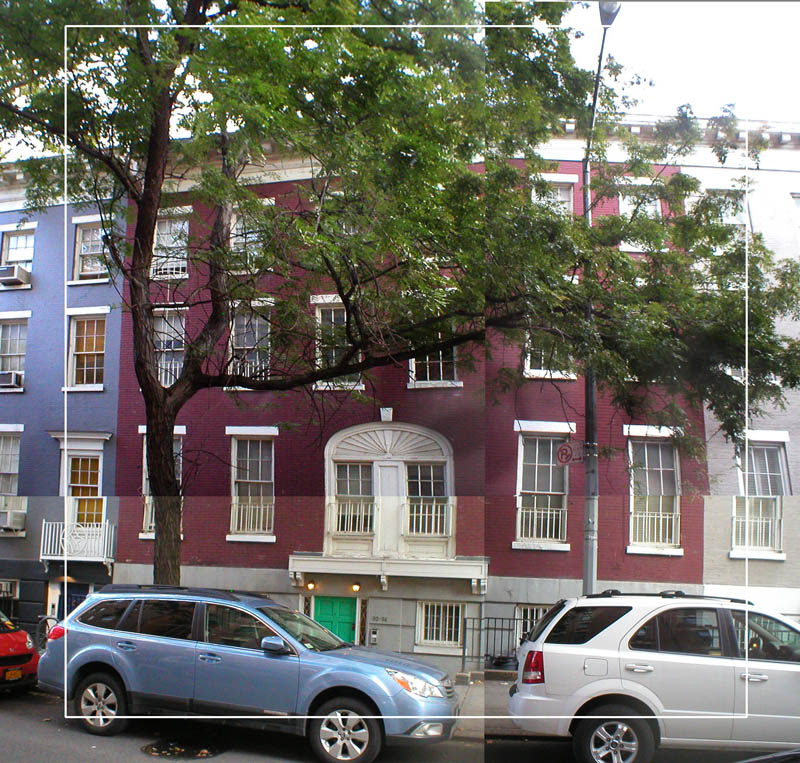
Dylan's townhouse shared a large, somewhat communal inner block of trees and greenery, which I think is partially divided by fences. Anna Wintour of Vogue lives in one of those townhouses on the right. 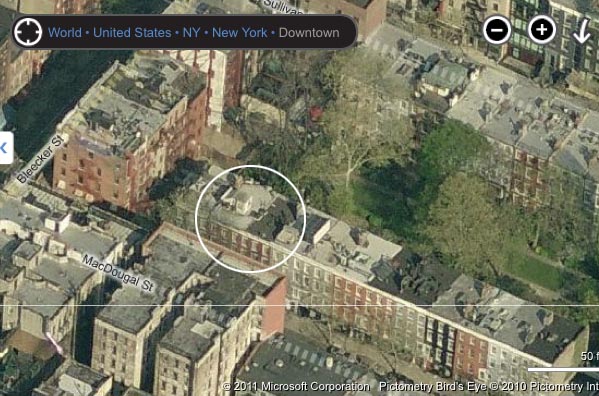
Here's a Google Earth- eye view of Dylan's roof. Remember, his townhouse has the red front and green door (#94). 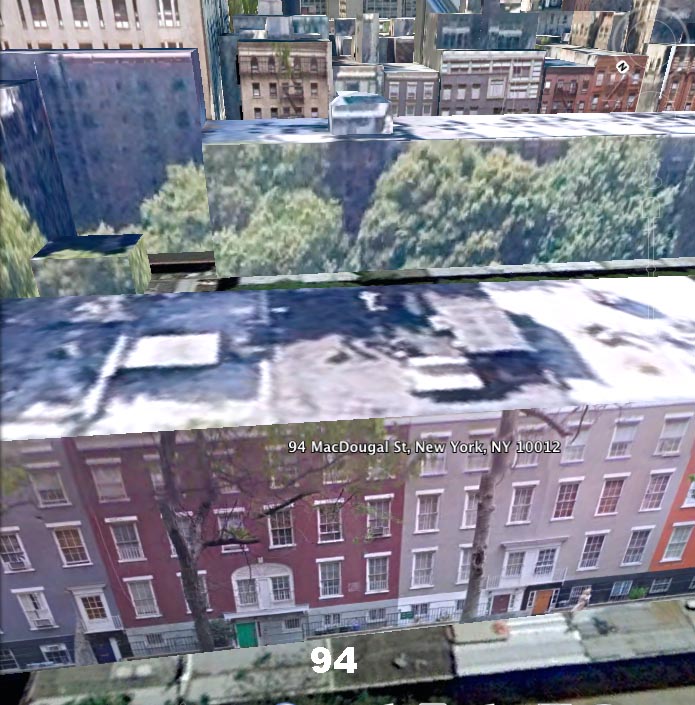
And here's another Google Earth's eye-view, showing how close Dylan was to Bleecker and MacDougal, the epicenter his old haunts and the 60's folk revolution 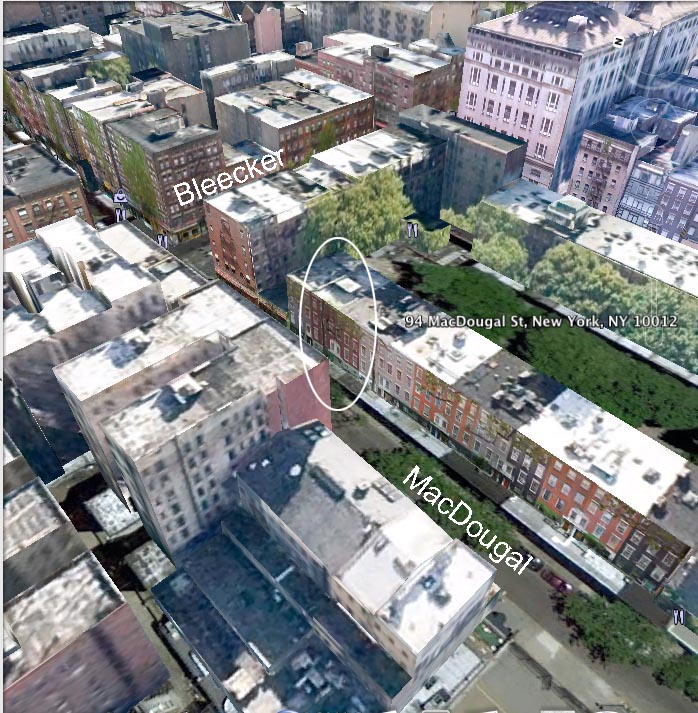
So it was on the roof of this building that John Cohen's photo session began with Dylan in 1970. This is one photo of the session reproduced in Cohen's book. (Photo by John Cohen) The tall pointed building in the far back is Hayden Tower, a dorm of NYU (New York University). A residence hall, it is located on the west side of Washington Square Park. 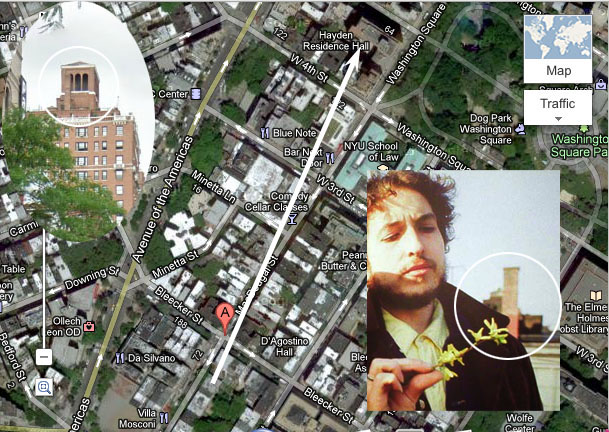
This is Hayden Hall again viewed from Macdougal Street just below West 4th Street (Dylan 's first apartment in NYC was 2 blocks west of here at 161 West 4th Street (the street that gave it's name to "Positively 4th Street"). Neil Young's After the Gold Rush album cover was taken on the other side of that big brick building on the right, which are the classrooms for NYU Law School. (see PopSpot #1) 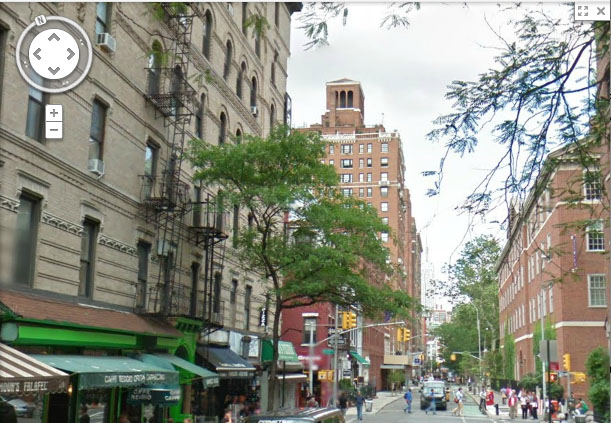
The picture on this 45-rpm Japanese record, as found online by Marie, was also taken during the rooftop session... 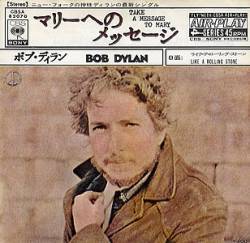
...as was this close-up. 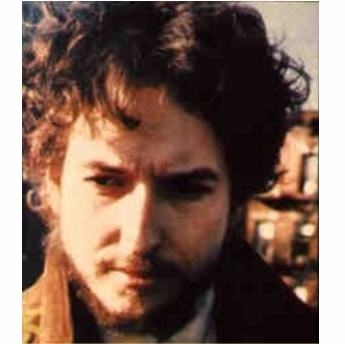
For this one, an outtake shown at the French exhibit, Dylan's up against a small white building with glass windows. 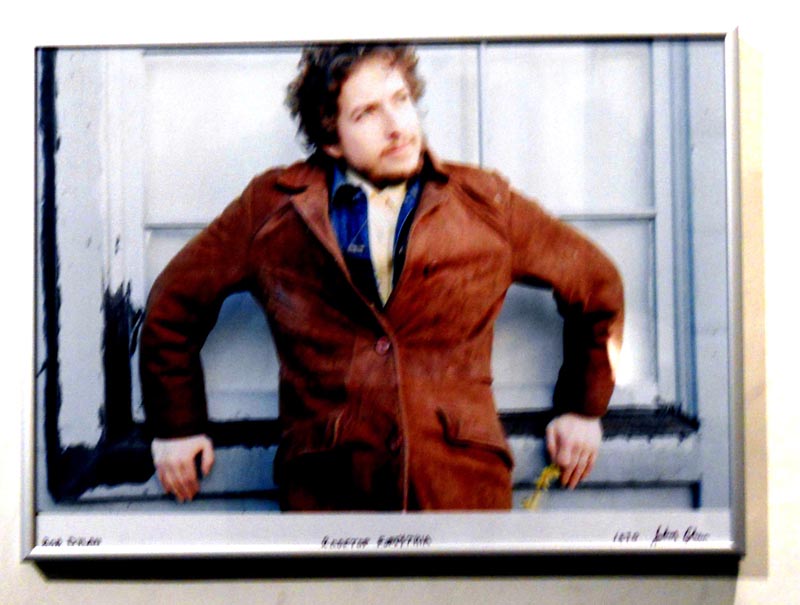
(Exhibit photo by John Cohen via Marie Fotini) It was probably this small structure on Dylan's roof. 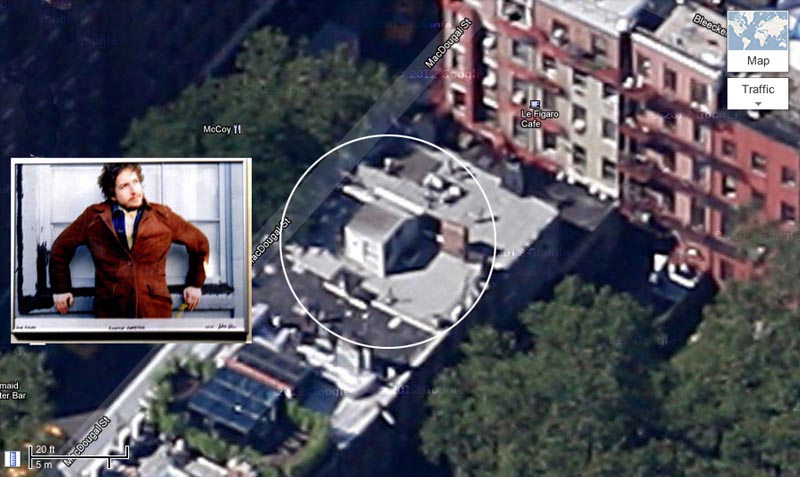
You can almost see it from the backyard tables of "Pizza Box" on Bleecker between MacDougal and Sullivan (the pizza's good - check it out!). 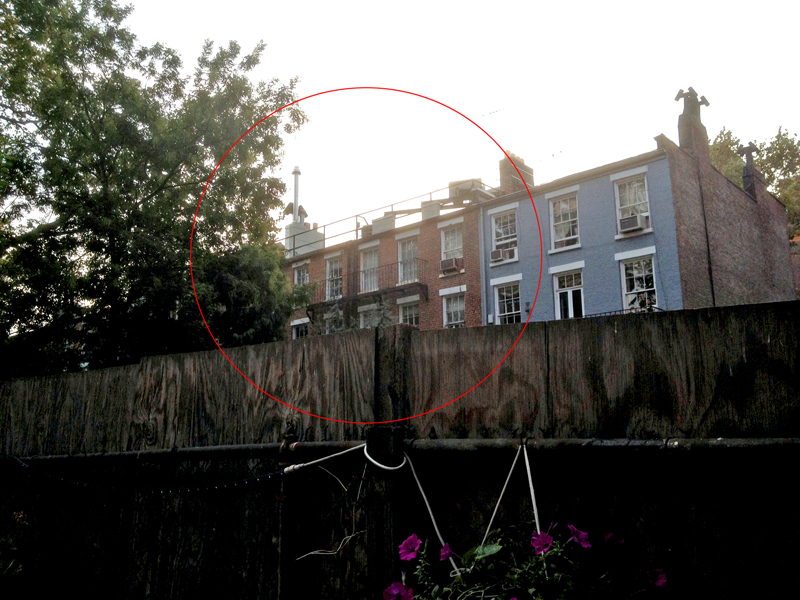
So after the rooftop photos, Cohen and Dylan went down to the street. This next picture, it turns out was taken in front of the playground at the southern end of Dylan's block. 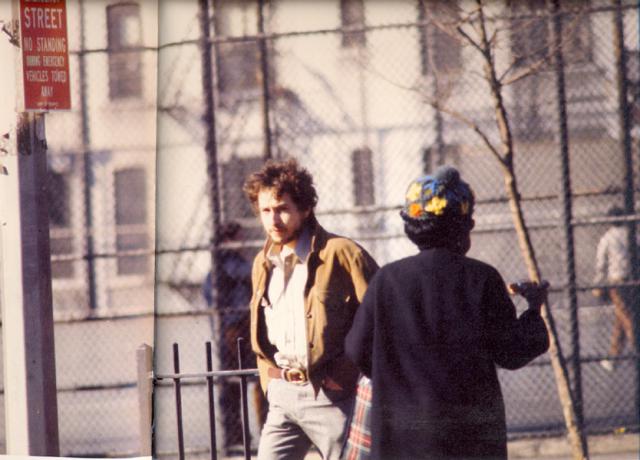
(Photo by John Cohen) Except that, I didn't know that yet. This was one of the photos that Marie sent me from France. She could see that the fire escape in back of Dylan's head matched the fires escape in real life. And the windows over the women's head matched up, too. As did the street lamppole and sign on the left. But neither of us could figure out where the fence, circled in red, came from.
(Inner photo by John Cohen from "Young Bob") For a while we figured that the small fence had been in the middle of the street on the island, and was later replaced by the chain. But that didn't make sense, because if Dylan was in front of the fence he would have the been in the street in front of the island. And the woman crossing the street in the street in front of him! So it was back to back la good old drawing board for the intercontinental team. 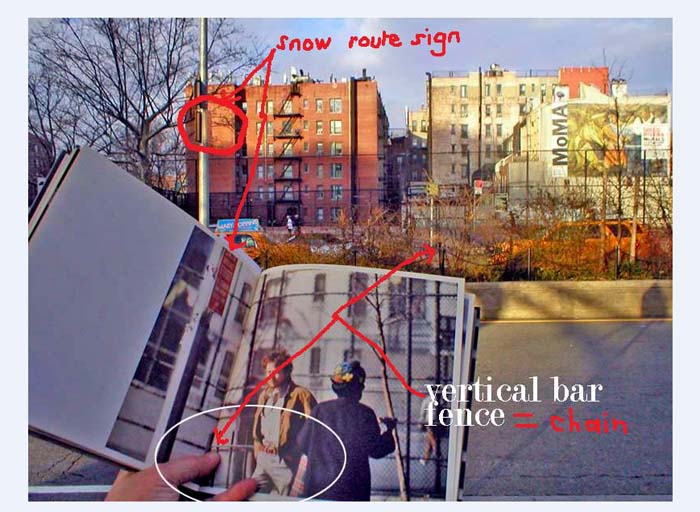
(Inner photo by John Cohen from "Young Bob") With Marie's strong cheerleading (something like, "I sure Bob if you go there and give it more time, you will figure it out like you did the other PopSpots.") I went downtown after work for several nights and walked around looking for clues. (Actually, it looks like Dylan is intently looking for clues in this shot, too!)
(Photo by John Cohen) Finally, it dawned on me that the photo could have been taken from another angle but with the same fire escape, etc. in the background. So I walked to the MacDougal/Houston intersection and looked at the building through a telephoto lens.
That made me start thinking about the thin tree that was in back of the woman. It seemed to no longer be on that side of the street. And being 42 years old, it should have been a huge tree by now. 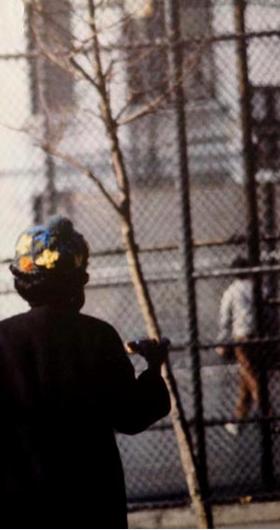
(Photo by John Cohen) So I went home and found the tree on Google Street Maps. It was in the right position if the shot had been taken at the corner. But how come I hadn't seen it? 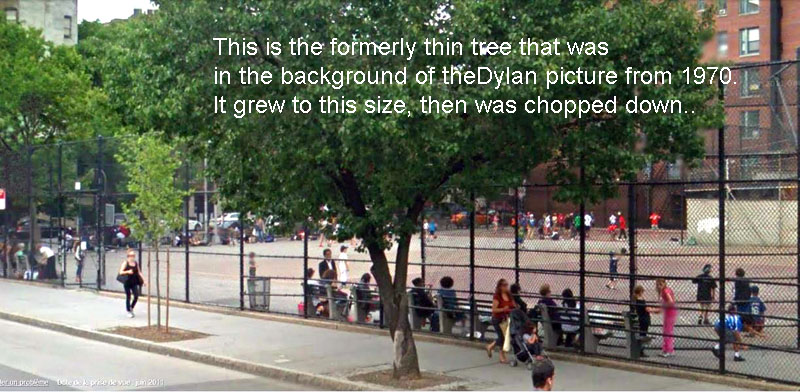
So I went back down to Houston Street and found that the tree had been cut down since the Google Street Maps photo. 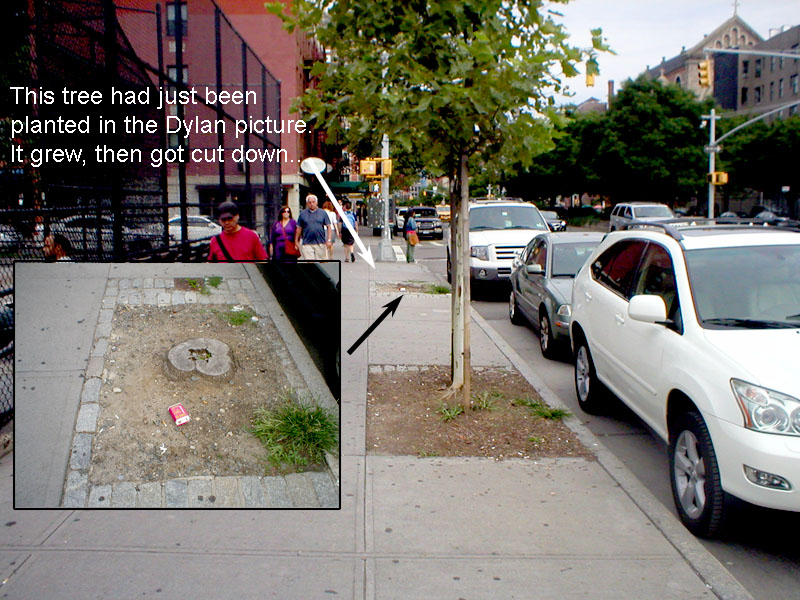
Now in case that's getting complicated, Here it all is in a diagram. I figured that John Cohen took the photo from the spot at the bottom of the white line, at the southeast corner of MacDougal and Houston, and the shot went past the woman, past Dylan, past the snall fence, through the playground and to the building. 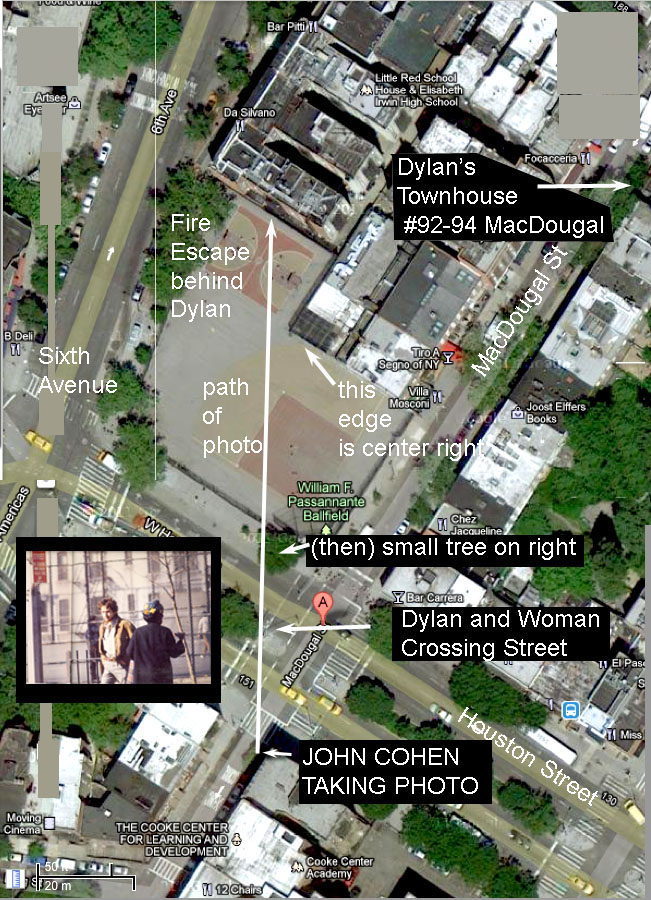
So the next night I went there after work and set up a telephoto shot to recreate the perspective of the shot. 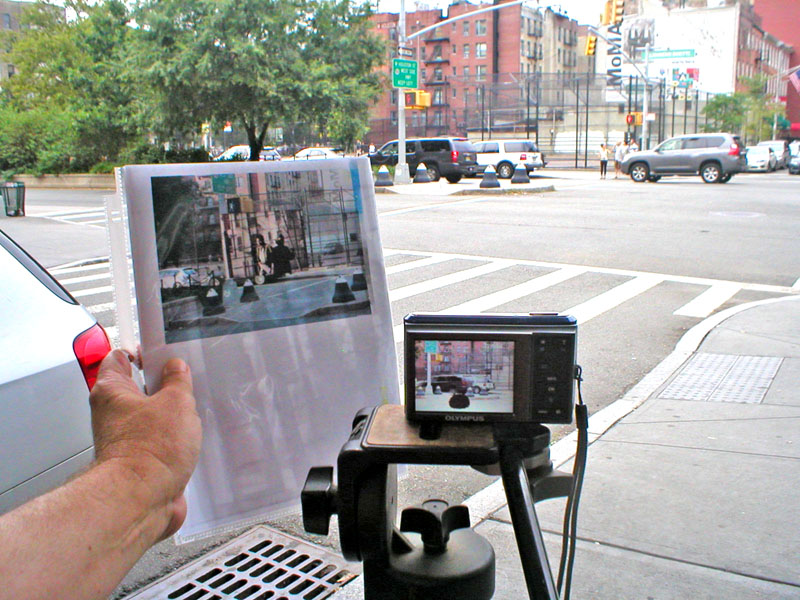
As it happened a guy and girl walked across the intersection separated by about one minute. So I photographed each of them where Dylan and the woman would have been without moving the camera. Later that night,I blended the pictures together as one in Photoshop. The scene of the two people crossing ended up looking just like Dylan and the Women when they passed each other (see next picture). 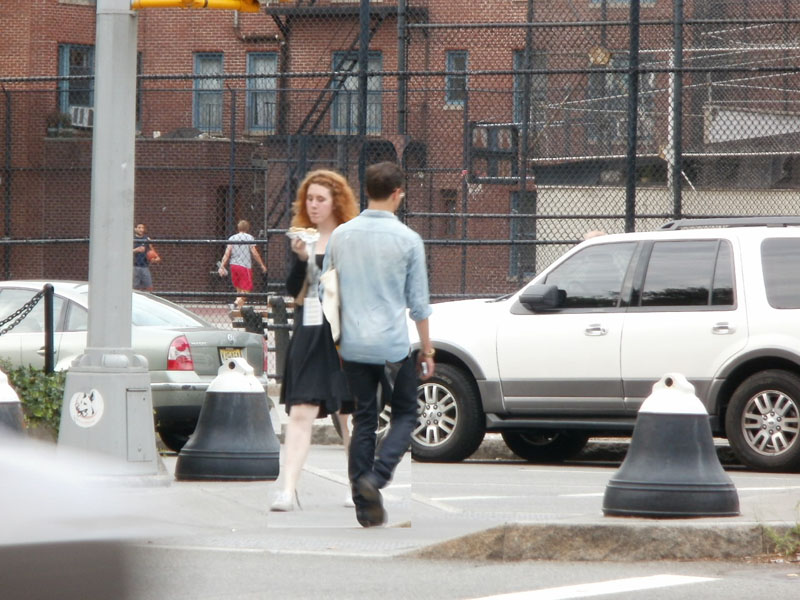
So that was the shot. And the mystery fence behind Dylan was located on the island, as you can see in the picture just below below this. 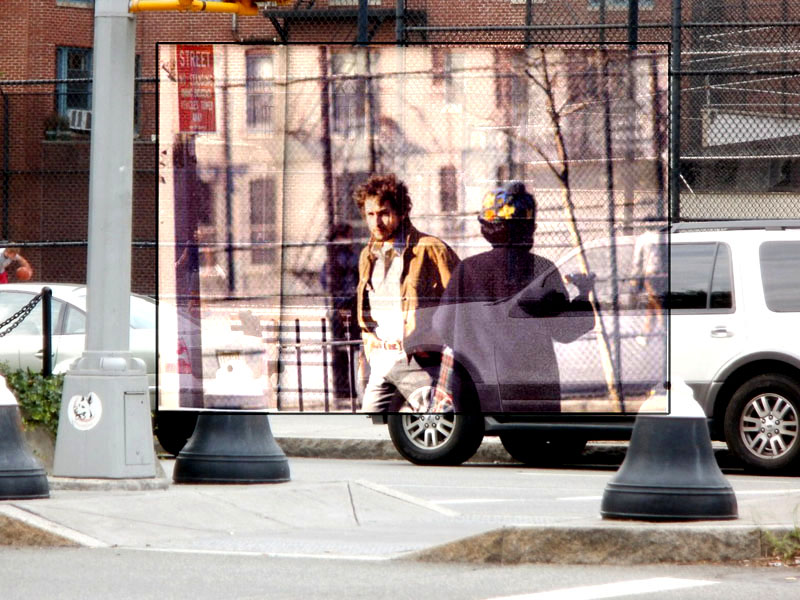
(Interior photo by John Cohen) Note the same shape metal fence, circled, on the island in the middle of Houston Street in the foreground of this picture (which we will soon be discussing). 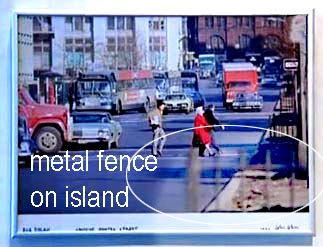
(Photo by John Cohen via Marie Fotini) Which brings us to our next photo of Dylan on Houston Street. In the photo Dylan is carrying a drum and walking south, away from his house on Houston Street. I am fairly certain that Dylan had a small recording studio on Houston Street during these years (I don't have the exact address yet) and he could have been dropping the drum off. (Which, by the way, would mean the previous photo came after this one in the session, unless Dylan was just walking back and forth across streets so Cohen could get the shot) The picture above did not have many clues to it's exact location, so Marie sent me a picture she had taken at the Cohen exhibit in France that showed a big red building in the background. 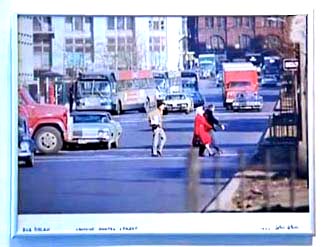
(Photo by John Cohen via Marie Fotini) That building I recognized as the Puck Building, which is on Houston, a block east of Broadway. In the Dylan photo, it would be seven blocks in back of Dylan. 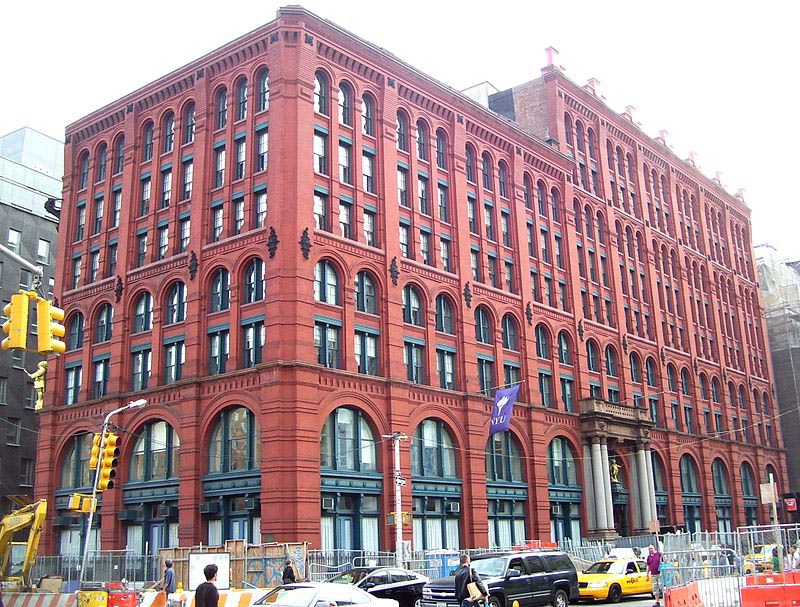
I also recognized the large gray building to the left to be where the Angelica Theater (an art movie house which opened in 1989) is on Houston at Mercer Street. 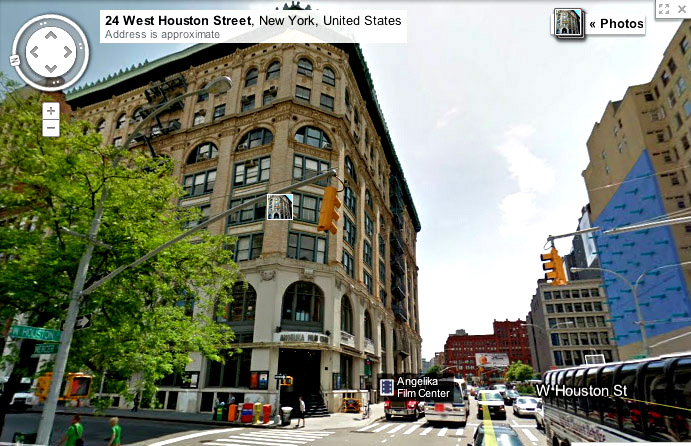
The building housing the Angelica is on the far right in this 1928 photo which looks west down Houston Street. (Looks like a Cow Town!) You can't see the angled part of the Angelica building where the stairs are now. 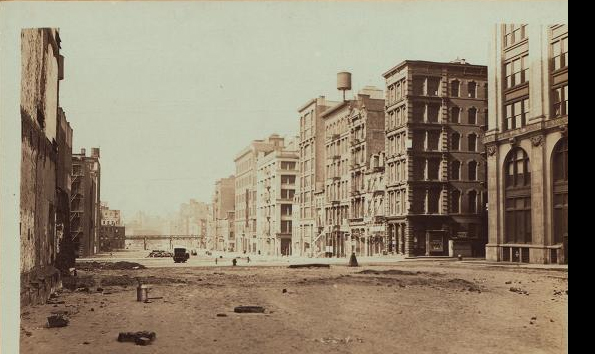
(Photo from NYPL Digital Archives) Based on those photos, Marie and I agreed that Dylan was one block west of the bus stop at LaGuardia place (pictured: below right), which would mean Dylan was walking south across Houston at Thompson Street. 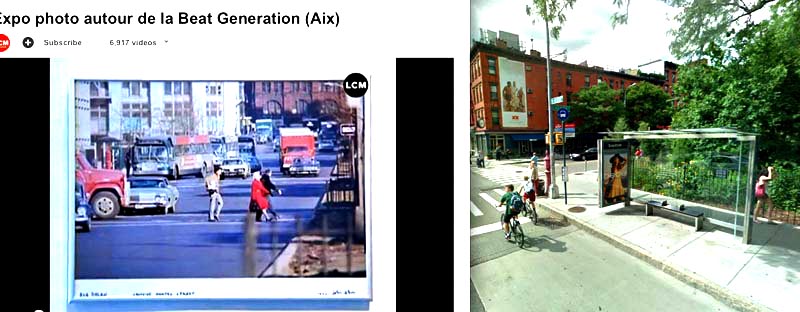
So I took a shot down Houston... (Photo at left by John Cohen via Marie Fotini) ...and put Dylan and drum in it. 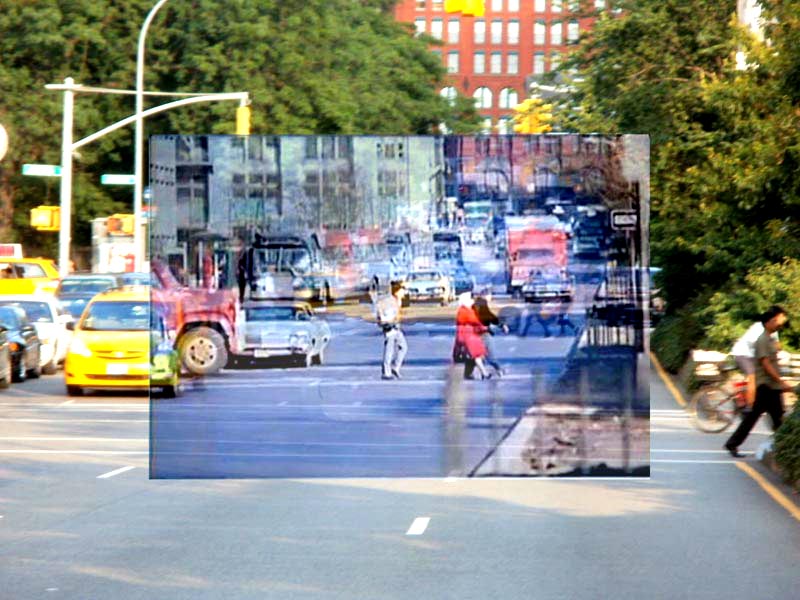
(Inner photo by John Cohen) Here's the map of it from above. 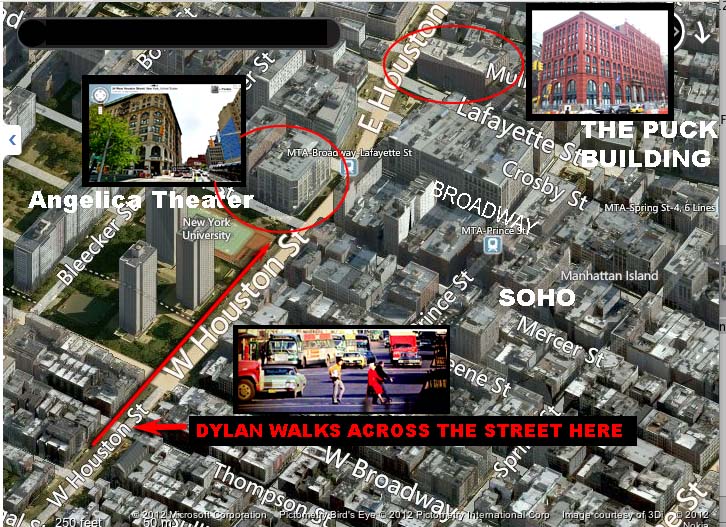
The next shot was probably the hardest to figure out. For some reason the sidewalk looks really tilted down to the right. And becuse the architecture in back of Dylan resembles that of Victorian towns along the Hudson River upstate, I thought for a long time that Dylan was in Sleepy Hollow (of the headless horseman fame) or someplace about 40 miles north of Manhattan. But once Marie and I figured where Dylan was walking with the drum in the other shot, we figured Dylan was likely still around Houston Street somewhere. So I put on my detective hat (figurtively speaking) and walked along Houston Street east of MacDougal in search of "Victorian Dylan." 
(Photo by John Cohen) About two blocks east, between Sullivan and Thompson, this spot intrigued me. Although the sidewalk wasn't on an angle, and there was no oil pipe on the left hand side going into the sidewalk, and the colors of the bricks were different, several things seems to match up: 1) The pilasters all had corinthian (leafy) columns. (See top red circles and yellow squares) 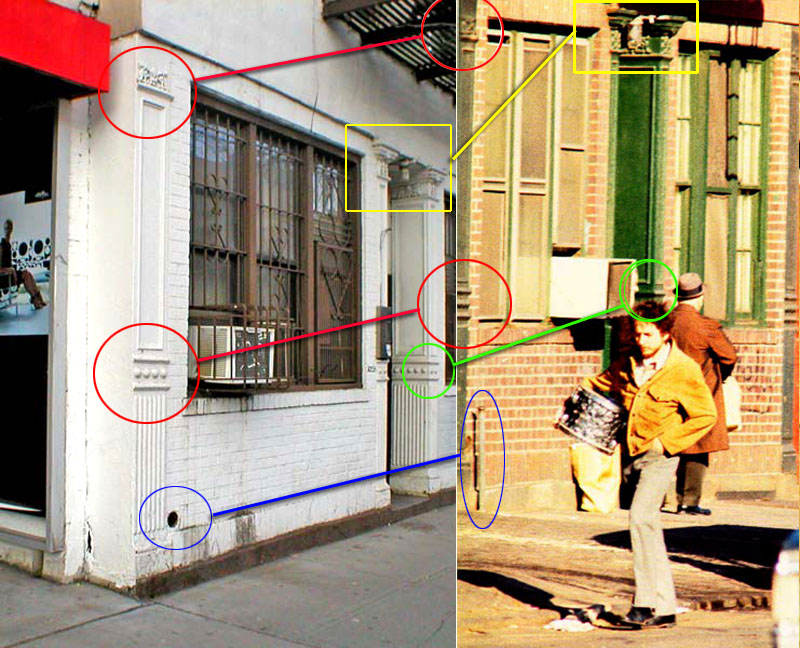
Here's a close-up so you can see how the light-fixtures matched ...and here's the light fixture from another angle, in case that was a little blurry for you. The address would be 112 West Houston Street. (The street is pronounced "How-stun," unlike the city in Texas, which is pronuonced Hugh-stun.) And here's A look at the the fire escape. It was in the same location as the one behind Dylan in the earlier picture. 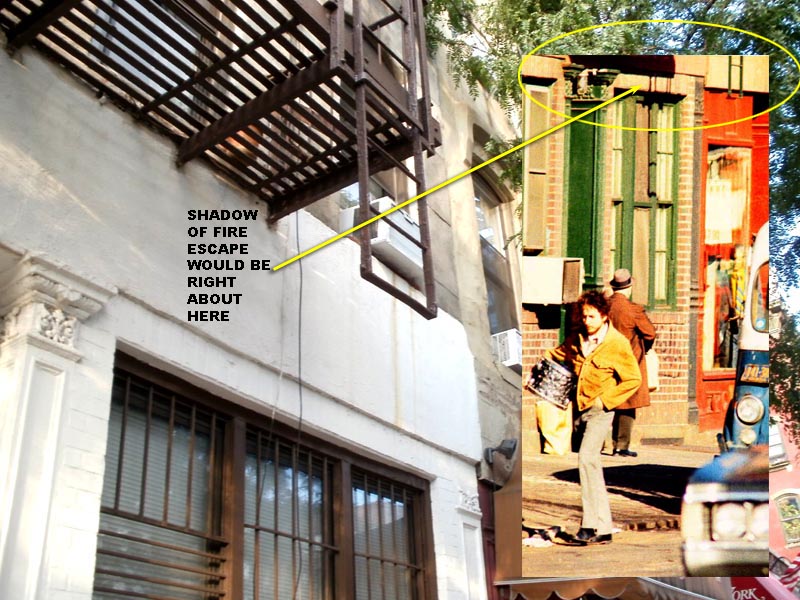
So I had to see how it would look with a telescopic lens perspective, as Cohen would have taken it. So I walked to the island in the middle of Houston, right where John Cohen must have stood 42 years before. 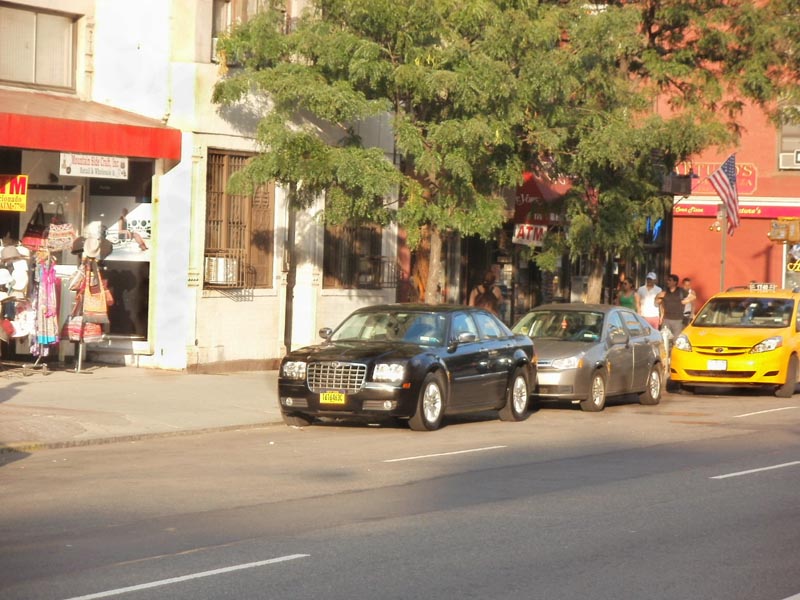
I zoomed in... Then I zoomed out -- just so you could see how far away I was. (Getting dizzy?) Then I put Mr. Dylan into the scene. See how the three horizontal bands in the pillars on the left match up? 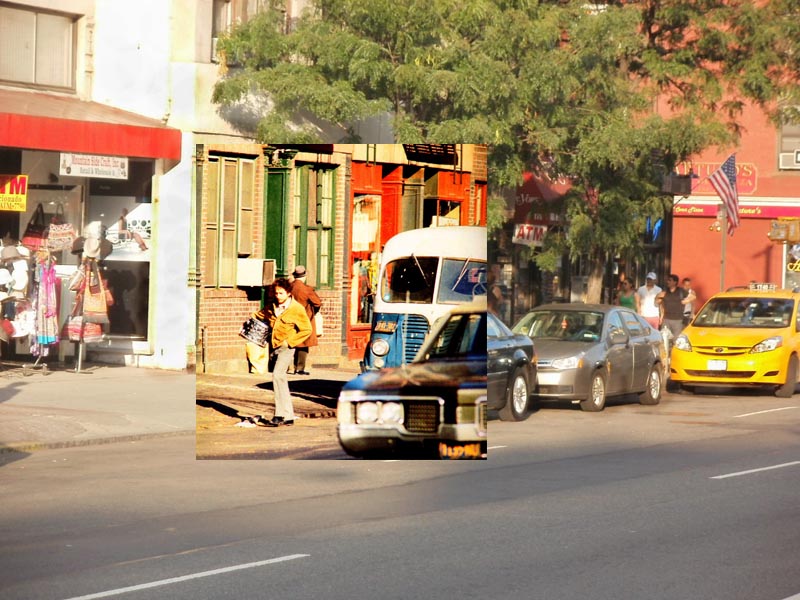
(Inner photo by John Cohen) Then I went full PopSpot, so we can see through Dylan and see how it all matches up from the doorway to the fire escape, to the building next door. 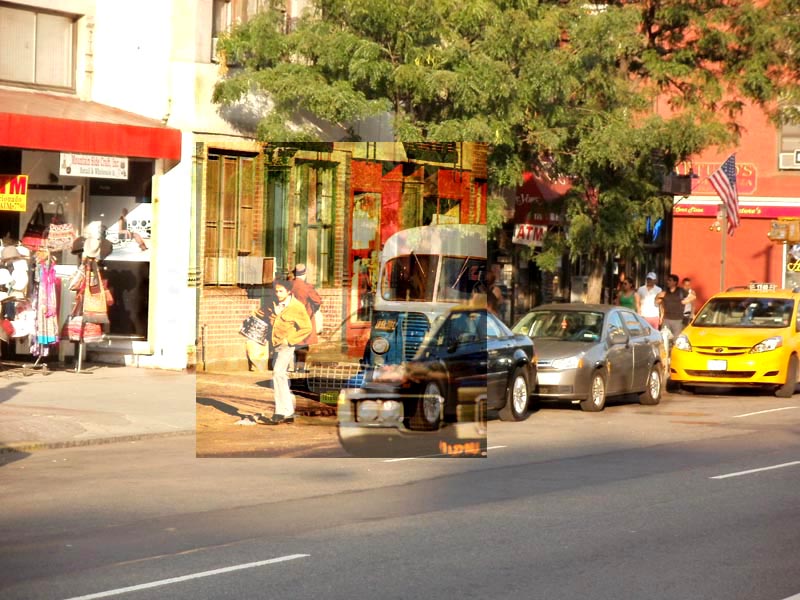
(Inner photo by John Cohen) Here's the map from overhead, in case you want to visit the spot. 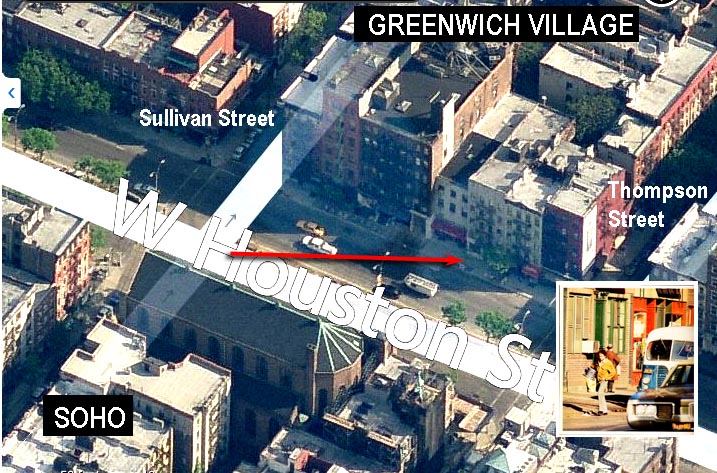
The last three photos of this group all seem to have been taken on the same corner: the southeast corner of Houston Street where it meets Sixth Avenue. The unifying clue would be the bright red fire alarm box that I have circled in each of the next three photos. Southeast cover of Sixth Avenue and Houston Street, looking west - #1. (Photo by John Cohen) Southeast cover of Sixth Avenue and Houston Street, looking west - #2. (Photo by John Cohen) Southeast cover of Sixth Avenue and Houston Street, looking west - #3. 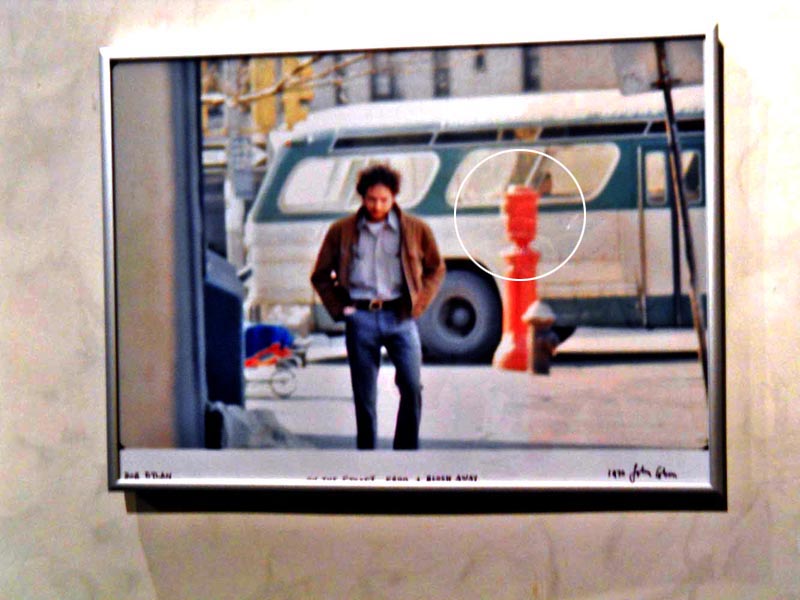
(Photo by John Cohen) (Note: The text below the picture says, "On the street from a block away.") Here is a picture that I took one night of that corner - the southeast corner of Sixth Avenue and Houston Street. Note that the red alarm box (now painted darker red) lines up near the black and white hydrant, as in the Cohen photo above. Here's a close-up of the fire alarm behind Dylan. If this is the correct one, and I'm assuming it is, it has been given a new top - in the shape of a torch. 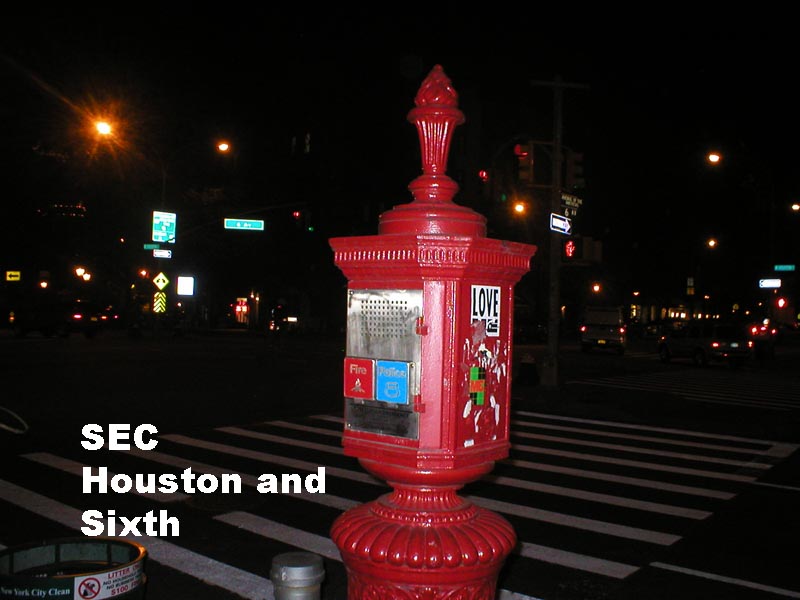
Standing where I figured Cohen took his photo, I took a photo of the corner using a telescopic lens. In the resulting photo, you can see how the fire hydrant and fire alarm seem closer to each other than in real life. Keep and eye on the the "6th Avenue street sign and the yellow Walk/Dont Walk sign at left. They will also be in the next Dylan photo to follow. So here's how my photo and Cohen's photo of the corner match up. Another PopSpot you can visit. 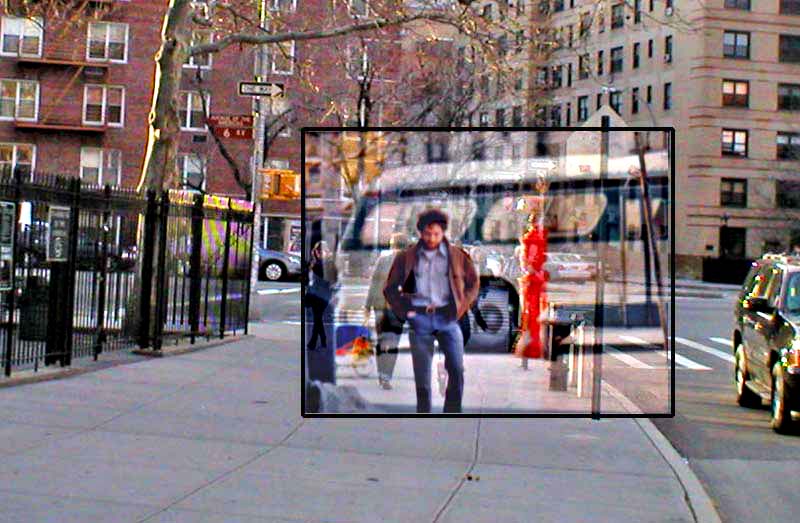
(Inner photo by John Cohen) I'll leave you with this map of Houston Street showing where all those photographs took place, so you can stop on by during your next visit to New York City. Don't forget to bring your telephoto! 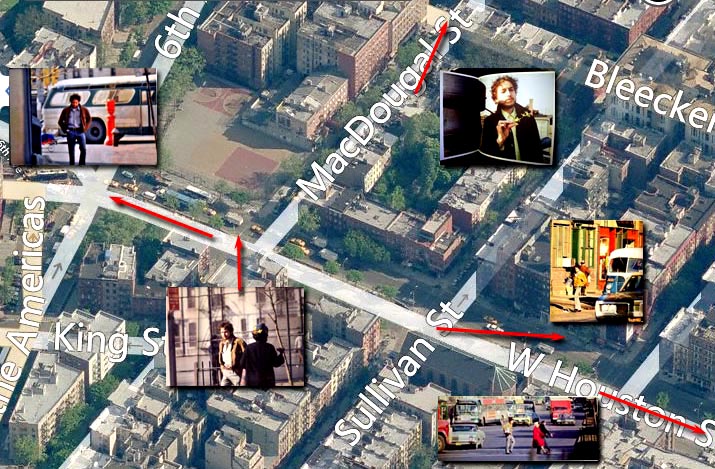
And that's the end of this little journey of where Houston Street meets Pop history. Thanks for dropping in. And thank you John Cohen for all the intriguing and captivating images. TO READ MORE ABOUT JOHN COHEN'S UPCOMING BOOKS AND FILMS, CLICK HERE. |
||

